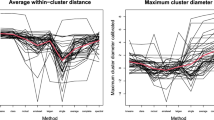Abstract
Cluster analysis aims at identifying groups of similar objects and, therefore helps to discover distribution of patterns and interesting correlations in large data sets. It has been subject of wide research since it arises in many application domains in engineering, business and social sciences. Especially, in the last years the availability of huge transactional and experimental data sets and the arising requirements for data mining created needs for clustering algorithms that scale and can be applied in diverse domains.
This paper introduces the fundamental concepts of clustering while it surveys the widely known clustering algorithms in a comparative way. Moreover, it addresses an important issue of clustering process regarding the quality assessment of the clustering results. This is also related to the inherent features of the data set under concern. A review of clustering validity measures and approaches available in the literature is presented. Furthermore, the paper illustrates the issues that are under-addressed by the recent algorithms and gives the trends in clustering process.
Similar content being viewed by others
References
Berry, M.J.A. and Linoff, G. (1996). Data Mining Techniques For Marketing, Sales and Customer Support. John Wiley & Sons, Inc., USA.
Bezdeck, J.C., Ehrlich, R., and Full, W. (1984). FCM: Fuzzy C-Means Algorithm. Computers and Geoscience, 10(2-3), 191-203.
Dave, R.N. (1996). Validating Fuzzy Partitions Obtained Through c-Shells Clustering. Pattern Recognition Letters, 17, 613-623.
Davies, D.L. and Bouldin, D.W. (1979). A Cluster Separation Measure. IEEE Transactions on Pattern Analysis and Machine Intelligence, 1(2), 224-227.
Dunn, J.C. (1974). Well Separated Clusters and Optimal Fuzzy Partitions. J. Cybern., 4, 95-104.
Ester, M., Kriegel, H-P., Sander, J., and Xu, X. (1996). A Density-Based Algorithm for Discovering Clusters in Large Spatial Databases with Noise. In Proceeding of 2nd Int. Conf.On Knowledge Discovery and Data Mining, Portland (pp. 226-23).
Ester, M., Kriegel, H.-P., Sander, J.,Wimmer, M., and Xu, X. (1998). Incremental Clustering for Mining in a Data Warehousing Environment. In Proceedings of 24th VLDB Conference, New York, USA.
Fayyad, M.U., Piatesky-Shapiro, G., Smuth P., Uthurusamy, R. (1996). Advances in Knowledge Discovery and Data Mining. AAAI Press.
Gath I. and Geva A.B. (1989). Unsupervised Optimal Fuzzy Clustering. IEEE Transactions on Pattern Analysis and Machine Intelligence, 11(7), 773-781.
Guha, S., Rastogi, R., and Shim K. (1998). CURE: An Efficient Clustering Algorithm for Large Databases. In Proceedings of the ACM SIGMOD Conference.
Guha, S, Rastogi, R., and Shim K. (1999). ROCK: A Robust Clustering Algorithm for Categorical Attributes. In Proceedings of the IEEE Conference on Data Engineering.
Halkidi, M., Vazirgiannis, M., and Batistakis, I. (2000). Quality Scheme Assessment in the Clustering Process. In Proceedings of PKDD, Lyon, France.
Han, J. and Kamber, M. (2001). Data Mining: Concepts and Techniques. Morgan Kaufmann Publishers, USA.
Hinneburg, A. and Keim, D. (1998). An Efficient Approach to Clustering in Large Multimedia Databases with Noise. In Proceedings of KDD Conference.
Huang, Z. (1997). A Fast Clustering Algorithm to Cluster very Large Categorical Data Sets in Data Mining. DMKD.
Jain, A.K., Murty, M.N., and Flyn, P.J. (1999). Data Clustering: A Review. ACM Computing Surveys, 31(3), 264-323.
Krishnapuram, R., Frigui, H., and Nasraoui, O. (1993). Quadratic Shell Clustering Algorithms and the Detection of Second-Degree Curves. Pattern Recognition Letters, 14(7), 545-552.
MacQueen, J.B. (1967). Some Methods for Classification and Analysis of Multivariate Observations. In Proceedings of 5th Berkley Symposium on Mathematical Statistics and Probability, Volume I: Statistics, pp. 281-297.
Milligan, G.W. and Cooper, M.C. (1985). An Examination of Procedures for Determining the Number of Clusters in a Data Set. Psychometrika, 50, 159-179.
Milligan, G.W., Soon, S.C., and Sokol, L.M. (1983). The Effect of Cluster Size, Dimensionality and the Number of Clusters on Recovery of True Cluster Structure. IEEE Transactions on Pattern Analysis and Machine Intelligence, 5, 40-47.
Mitchell, T. (1997). Machine Learning.McGraw-Hill, USA.
Ng, R. and Han, J.(1994). Effecient and Effictive Clustering Methods for Spatial Data Mining. In Proceeding's of the 20th VLDB Conference, Santiago, Chile.
Pal, N.R. and Biswas, J. ( 1997). Cluster Validation Using Graph Theoretic Concepts. Pattern Recognition, 30(6), 847-857.
Rezaee, R., Lelieveldt, B.P.F., and Reiber, J.H.C. (1998). A New Cluster Validity Index for the Fuzzy c-Mean. Pattern Recognition Letters, 19, 237-246.
Sharma, S.C. (1996). Applied Multivariate Techniques.John Wiley and Sons.
Sheikholeslami, C., Chatterjee, S., and Zhang, A. (1998). WaveCluster: A-MultiResolution Clustering Approach for Very Large Spatial Database. In Proceedings of 24th VLDB Conference, New York, USA.
Smyth, P. (1996). Clustering using Monte Carlo Cross-Validation. In Proceedings of KDD Conference.
Theodoridis, S. and Koutroubas, K. (1999). Pattern Recognition.Academic Press.
Theodoridis, Y. (1999). Spatial Datasets: An “unofficial” collection. http://dias.cti.gr/~ytheod/research/ datasets/spatial.html Wang, W., Yang, J., and Muntz, R. (1997). STING: A Ststistical Information Grid Approach to Spatial Data Mining. In Proceedings of 23rd VLDB Conference.
Xie, X.L. and Beni, G. (1991). A Validity Measure for Fuzzy Clustering. IEEE Transactions on Pattern Analysis and Machine Intelligence, 13(4), 841-846.
Zhang, T., Ramakrishnman, R., and Linvy, M. (1996). BIRCH: An Efficient Method for Very Large Databases. ACM SIGMOD, Montreal, Canada.
Author information
Authors and Affiliations
Rights and permissions
About this article
Cite this article
Halkidi, M., Batistakis, Y. & Vazirgiannis, M. On Clustering Validation Techniques. Journal of Intelligent Information Systems 17, 107–145 (2001). https://doi.org/10.1023/A:1012801612483
Issue Date:
DOI: https://doi.org/10.1023/A:1012801612483




